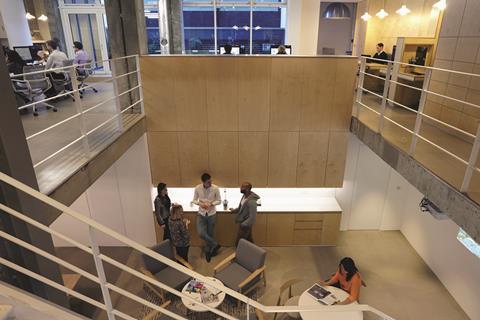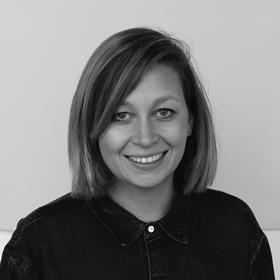The world of work is changing. Forget being chained to a desk, a boss you only see through their office window and strict working silos. To attract and keep the top talent of the new generation, companies need to embrace a different office culture. Building spoke to three millennials about their working environment

The working environment is not what it once was. The words “agile” and “flexible” are no longer restricted to yoga class; they have followed us into the office. For previous generations, being pried from their offices may take some getting used to, but with millennials (those born between the early 1980s and early 2000s) predicted to make up 75% of the workforce by 2025, companies are going to have to up their game if they want the pick of the top talent.
As images of Google HQ, with swings and a ball pit, fill them with expectations of office life, it seems offering young recruits a competitive wage is not enough. You have to tempt them with shiny screens, basement gyms and skyline views too.
Companies don’t just need to recruit millennials; they also need to keep them from jumping ship. Personal development, flexible working and an engaging environment all feature high on millennials’ working wish list.
In a PwC survey of 4,364 graduates in 2011, personal development was millennials’ top employee benefit - with flexible working hours and cash bonuses in second and third place respectively. For a generation that has invested heavily in a university education, joining the workforce with large amounts of debt, it’s no surprise that personal development is a high priority.
Mixing with more senior members of the team is also important. Rosie Haslem, director of workplace consultancy at design consultant Spacelab says: “younger, newer staff need management and guidance, so ensuring proximity or access to senior staff is really important in an agile working environment, to help them learn and progress.”
This goes hand in hand with PwC’s survey, which revealed “millennials tend to be uncomfortable with rigid corporate structure. They expect rapid progression, a varied and interesting career and constant feedback.”
This shift towards a flexible, agile culture without a hierarchy of offices can be clearly seen in Spacelab’s HQ in London, with walls you can write on, desks that belong to nobody and separate study areas with pull-out shiny screens.
There is, however, more to the office than its appearance. Its changing design has skyrocketed efficiency by increasing understanding of how employees use space. Haslem says: “Space is not just a commodity, it’s a communication tool. People have re-recognised [the office’s] importance as a place to come together.”
Communication in an office is vital according to Julian Sharpe, principle director at architect TP Bennett. In a recent blog for building.co.uk on the subject he said: “It isn’t that millennials don’t want a serious environment, but in order to provide spaces that work for them, we must then design schemes that provide good, clear opportunities for information, learning and connection.
“Where some organisations fail is by offering a half-way attempt to cater for the requirements of new talent, but without the design commitment to support today’s working practices.”
And as millennials fit into the changing workplace, it’s clear their working life will be a far cry from that of their parents, who may never have met the directors of their companies. Millennials may end up sitting next to theirs.
Below we hear to three millennials about what makes their working environments work for them.
Millennials’ views: What makes my office work
‘A conscious decision’
Sophie Norris, 27, architectural designer at Spacelab

Q. What do you like about your office in London’s Hoxton area?
A. The people and the connection between each individual, which I think would be lost without the flexible working nature of the office. The agile way in which we work allows everyone to sit wherever they choose on a given day, which not only benefits productivity (if, for example, you need to work alongside a particular person on the same project), it also benefits the general mood day-to-day, as everyone can make a conscious decision about their working environment.
Q. Are there specific break out areas and do you use them often?
A. There are a number of breakout areas, which I tend to use regularly, particularly the lounge and library, which I usually use when working in a team for quick design workshops.
Q. Are there any aspects of your office that particularly enable communication with colleagues?
A. It is not specifically the seated areas that enable communication, but rather that people often stop to discuss something on the landing of the stairs, or leaning against the ledge/worktop that overlooks the void, and at the tea point - each of these areas are directly connected to the central void, which undoubtedly increases connectivity.
Q. Does your office enable interdisciplinary ways of working?
A. Yes, although I think it could be encouraged more than it currently is, specifically at the conceptual stages of a project. I would love to see more sketching and/or model making, as opposed to predominately computer-based work.
Q. In your next career move, would the office space be an important factor in your decision? Equal to or greater than salary/benefits?
A. Definitely. It will be hard reverting back to fixed desking after being at Spacelab. My next move will be back to New Zealand, so hopefully we are with the times and I can find a job in an architecture practice or design studio that provides agile ways of working.
‘Best views of the city’
Lucie Oliver, 31, senior architectural assistant at RSHP

Q. What do you like about your office in the Leadenhall Building in central London?
A. From my desk on the eastern side of the building there are great views of Lloyd’s of London, the Thames and St Paul’s Cathedral. Being just a 10-minute walk away from Shoreditch is perfect for meeting friends in the evening. I love the use of colour in the office; the bright green carpet and colourful chairs reflect the fun nature of the practice.
Q. Are there specific break out areas and do you use them often?
A. We have a kitchen with tables and a bar, which I use for breakfast, lunch and coffee breaks. There is also a central meeting space for informal internal and external meetings; this is often used for lectures and the regular office-wide meetings. There are also break out spaces in the two corners of the office, which have the best views of the city.
Q. Are there any aspects of your office that particularly enable communication?
A. The whole office is now on one floor, previously it was split between several buildings and floors. This visual connection means I am much more likely to go over and have a face-to-face conversation rather than phoning or emailing.
Q. Does your office enable interdisciplinary ways of working?
A. The office design allows for people and teams to easily move around the floor, making it flexible for teams to grow, move and reduce in size. The open nature of the office design creates moments of interaction between teams and specialties.
The new location and flexible meeting spaces make it easier to host large multi-disciplinary meetings; the magnetic whiteboard walls for sketching and displaying drawings are useful. All the meeting rooms have video conferencing equipment, which is critical to the teams working on overseas projects.
Q. In your next career move, would the office space be an important factor in your decision? Equal to or greater than salary/benefits?
A. When considering a new job, it would be a careful balance between the two. As with anywhere that I would spend long periods of time, the surrounding environment is critical to wellbeing and therefore an important consideration. Finally, the view from my desk would be hard to beat.
‘Different perspective’
Matt Peat, 24, assistant project manager at Turner & Townsend

Q. What do you like about your office at One New Change in the City of London?
A. Turner & Townsend’s new London office is based in One New Change, a relatively new development, which has lots of natural light and great views of St Paul’s Cathedral. I like that I can meet and interact with new colleagues on a daily basis, as most people who work from the office hot-desk.
Q. Are there specific break out areas and do you use them often?
A. Yes, there are different types of areas for alternative working and I use them all regularly. Long-stay areas are provided, which have a more traditional desk setting with a screen and phone. There are also short stay and breakout areas, which are useful for informal internal meetings, or the café area, which is good for a one-on-one catch-up.
Q. Are there any aspects of your office that particularly enable communication?
A. The breakout booths and quiet rooms are good for quick meetings. Turner & Townsend also host a monthly knowledge-sharing event in our largest meeting room, which can host larger training and networking events.
Q. Does your office enable interdisciplinary ways of working?
A. Teams generally mix with members of other teams, so it’s always easy to find a different perspective on something you’re working on.
Q. In your next career move, would the office space be an important factor in your decision? Equal to or greater than salary/benefits?
A. Yes, it will be an important factor. I think it’s vital to have a working environment that allows you to perform your job in a safe and enjoyable way as well as allowing you to develop personally and professionally. There will always be a balance to be found between working environment, company culture and salary/benefits, that’s very much down to you as an individual.



























1 Readers' comment